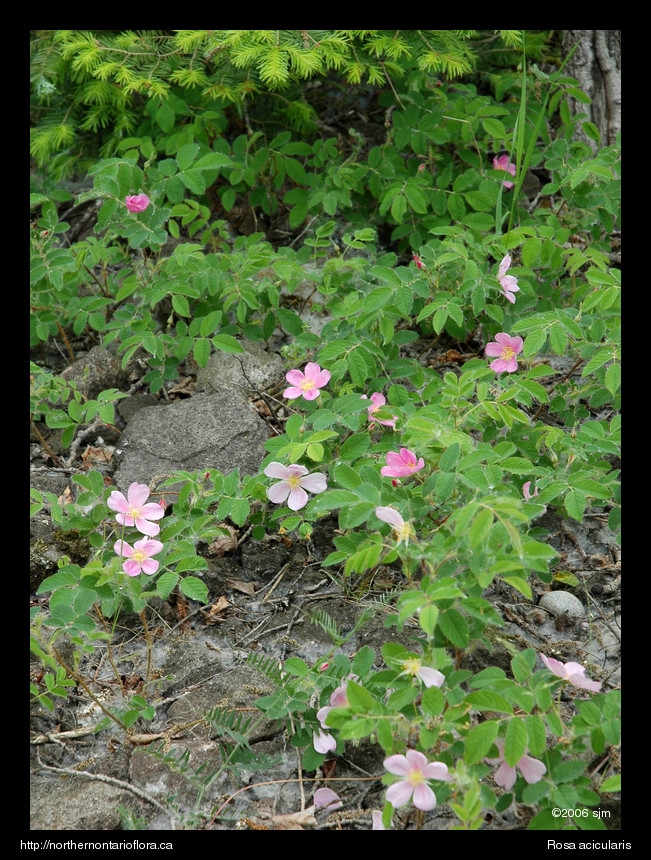
|
Northern Ontario Plant Database 
Plant DescriptionRosa acicularis Lindl.En: prickly wild rose
Rosaceae (Rose Family) General: A low, perennial, deciduous shrub to 1.2 m tall. Young and mature stems are densely armed with numerous slender bristles and slightly longer and stouter straight prickles, 3-4 mm long. Broad-based curved thorns are absent.Nomenclature: Rosa acicularis Lindl. subsp. sayi (Schwein.) W.H.Lewis is the subspecies found in Canada. Leaves: Alternate, pinnately compound, with a pair of stipules fused to the petiole for most of their length, broader above and ending in a free triangular tip. The leaf rachis is finely pubescent; glandular hairs are borne on the leaf rachis and stipule margins. Leaflets are usually 5-7, elliptic to obovate, 1.5 -5 cm long, dull and smooth (glabrous) above, paler and usually short-pubescent beneath. Tips of leaflets are blunt (obtuse) to pointed (acute); bases obtuse to rounded or slightly cordate; margins are toothed (single to double-serrate) nearly to the base. Flowers: Bisexual, usually solitary, 4-6 cm across. The base, or receptacle, of the flower forms a cup-shaped hypanthium, with the sepals and petals attached to the rim of the hypanthium. The flower stalk (peduncle) and hypanthium are smooth. The five green sepals are lanceolate with gradually tapering tips that end in tail-like (caudate) appendages. The outer surface of the sepals bears numerous glandular hairs, while the inner surface is densely white-pubescent. The five light- to deep-pink petals are obovate to obcordate. Stamens and pistils are numerous; the ovaries are contained within the hypanthium, but the short styles are densely clustered at the top of the hypanthium, forming a round 'brush' at the centre of the flower. Flowers bloom in early summer. Fruit: A smooth, reddish-orange, ellipsoid or obovoid rosehip, 1.5-2 cm long; sepals point forward in fruit. The fleshy hips, which matures in early fall, contain numerous small achenes. Rose hips have a high Vitamin C content and may be used dried to make teas or fresh to make jellies. Habitat and Range: Rocky or sandy shores, thickets, meadows, and open woods. Our most common rose, the prickly wild rose occurs throughout all regions of Ontario. Its range is nearly circumboreal, extending from Quebec to Alaska and west across northern Eurasia to Scandinavia. Internet Sites: This webpage on Rosa acicularis is from Colin's Virtual Herbarium, an excellent website from Saskatchewan. Several images of leaves, flowers, and herbarium specimens are included. Similar Species: Rosa blanda, the smooth or early wild rose, is found in similar habitats. Its upper branches are usually smooth or bear just a few scattered prickles, but the bases of older stems may be armed with several straight prickles. Rosa palustris, the swamp rose, is common in moist to wet areas, such as marshes, swamps, and along stream and lake margins. Its stems lack thin straight prickles, but a pair of stout, broad-based, recurved thorns are found at each node, just below the point of leaf attachment. Rosa palustris can be differentiated from R. acicularis and R. blanda by the many glandular hairs that cover the hypanthium and rosehips of the swamp rose. The webpages of Rosa blanda and Rosa palustris are from the Shrubs of Wisconsin website. Back to species list |
||||||||||||||||||||||












